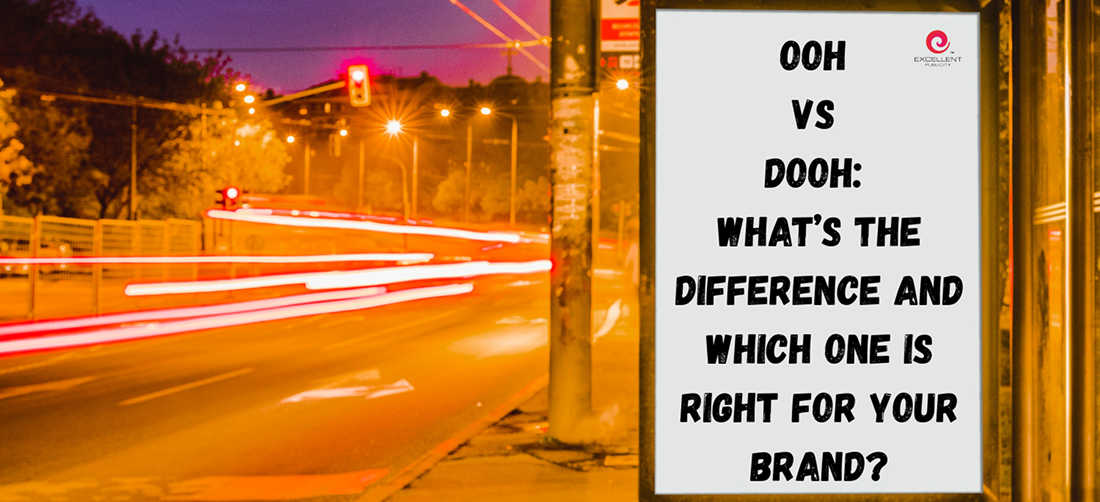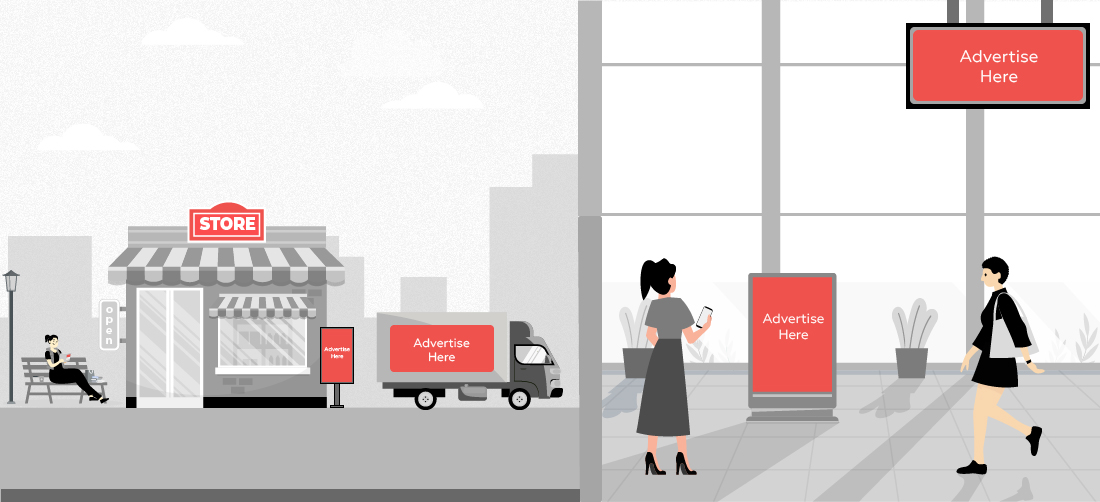In today’s fast-paced world of marketing, OOH (Out-of-Home) and DOOH (Digital Out-of-Home) advertising are often compared as brands look to build visibility in the physical world. Both are forms of outdoor advertising , but their execution, impact, and targeting capabilities are quite different.
Understanding the difference between OOH and DOOH can help you make smarter decisions when planning your media mix. This guide breaks down each format, their pros and cons, and when to use which, so your brand doesn’t just show up, but stands out.
What Are OOH and DOOH Advertising?
Before diving into comparisons, let’s first understand what these two formats mean.
OOH Advertising (Traditional Out-of-Home)
OOH advertising refers to any form of advertising that reaches people when they’re outside of their homes. These are static media formats placed in public spaces like roads, malls, or transit hubs.
Common examples:
- Roadside billboards
- Hoardings
- Posters on buildings
- Bus shelter ads
- Wall paintings in rural areas
OOH has been around for decades and remains one of the most effective mass-reach channels for awareness and branding.
DOOH Advertising (Digital Out-of-Home)
DOOH is a modern, tech-powered extension of OOH. Instead of static prints, DOOH uses digital screens to deliver animated, dynamic content, often scheduled or triggered by real-time data.
Common placements:
- LED billboards
- Digital mall screens
- Airport displays
- Metro station digital panels
- Interactive touchscreens in malls
This format allows for programmatic buying, real-time updates, and richer storytelling using motion visuals.
Key Differences Between OOH and DOOH
Feature
OOH
DOOH
Format
Static
Digital
Content Type
Printed/painted
Animated/video
Flexibility
Fixed content during campaign
Creatives can be updated anytime
Interactivity
None
Can be interactive (touch, motion)
Scheduling
One creative per location
Multiple creatives per screen
Buying Process
Manual
Programmatic options available
Measurement
Based on location & traffic
Integrates digital metrics & tracking
Types of OOH and DOOH Advertising
Key Differences Between OOH and DOOH
| Feature | OOH | DOOH |
|---|---|---|
| Format | Static | Digital |
| Content Type | Printed/painted | Animated/video |
| Flexibility | Fixed content during campaign | Creatives can be updated anytime |
| Interactivity | None | Can be interactive (touch, motion) |
| Scheduling | One creative per location | Multiple creatives per screen |
| Buying Process | Manual | Programmatic options available |
| Measurement | Based on location & traffic | Integrates digital metrics & tracking |
Understanding the types of OOH advertising and DOOH formats helps determine what fits your brand goals best.
Types of Traditional OOH Advertising:
- Billboards/Hoardings: Large format roadside ads.
- Transit Media: Ads on buses, autos, metro trains.
- Street Furniture: Bus stops, kiosks, pole ads.
- Wall Wraps: Seen on building facades or flyovers.
- In-cinema posters: Static formats in waiting areas.
Types of DOOH Advertising:
- Digital Billboards: LED boards on highways or urban centers.
- Retail Screens: Malls, supermarkets, food courts.
- Airport & Metro Screens: Dynamic formats in high-traffic hubs.
- Interactive Kiosks: Touch-enabled, motion-based engagement.
- Vehicle-Mounted Screens: LED screens on cars and buses.
An experienced outdoor advertising agency can help brands mix and match these formats based on budget and geography.
Pros and Cons: OOH vs DOOH
Let’s explore the benefits and limitations of each format:
Pros of OOH:
- Long-term visibility (24/7 exposure)
- Cost-effective for mass reach
- Ideal for brand recall and awareness
- Works well in rural and Tier 2/3 markets
Cons of OOH:
- No room for dynamic or real-time content
- Measurement is estimation-based
- Difficult to scale across multiple creatives
Pros of DOOH:
- Creative flexibility with dynamic visuals
- Time/day/location-based targeting
- Easier to measure impressions and engagement
- Integrates well with mobile and digital campaigns
Cons of DOOH:
- Higher production costs for animated content
- May require higher-tech infrastructure
- Not available in all rural markets yet
When Should You Choose OOH or DOOH?
Choosing between OOH vs DOOH depends on your brand’s objective, audience, location, and budget.
Choose OOH when:
- You want constant visibility in a prime location.
- Your audience is in low-tech or rural areas.
- You’re launching a long-term brand awareness campaign.
- You have limited creative production resources.
Choose DOOH when:
- You want to rotate offers or messages throughout the day.
- You need city-specific or time-sensitive campaigns.
- You’re combining it with mobile retargeting.
- You aim for higher engagement through visuals or interactivity.
Example:
A real estate brand might use OOH hoardings for city-wide presence, but switch to DOOH screens near malls with updated flat availability and offers.
How to Measure ROI: OOH vs DOOH
Measuring return on investment (ROI) is one area where DOOH has a clear edge, but both formats offer tracking potential with the right tools.
OOH ROI Measurement:
- Location-based audience data (via traffic counts)
- Pre- and post-campaign brand recall studies
- QR codes or vanity URLs
- Uplift in footfall or inquiries in target area
DOOH ROI Measurement:
- Impressions based on digital footfall and screen play rates
- Real-time analytics on playtime and frequency
- Mobile retargeting and engagement rates
- A/B testing of creatives on different screens
The ability to integrate mobile data, dwell time, and even conversion analytics makes DOOH more measurable in digital terms.
Best Practices for Integrated OOH + DOOH Campaigns
Rather than choosing one over the other, many brands now run integrated campaigns using both OOH and DOOH formats.
Here’s how to make it work:
- Use OOH for long-term presence, like at city entry points or highways.
- Use DOOH for dynamic storytelling, such as changing offers, festivals, or local events.
- Sync creatives for consistent branding across both.
- Use QR codes, geotags, or social hashtags to link physical ads to digital journeys.
- Leverage programmatic buying for DOOH to respond to weather, traffic, or time of day.
This mix improves reach, recall, and response, giving your campaign the best of both worlds.
How to Get Started with OOH + DOOH
Launching a campaign that involves both OOH and DOOH doesn’t have to be complex. Here’s a step-by-step plan:
- Define Goals: Awareness? Local footfall? Seasonal promotion?
- Know Your Audience: Where do they commute, shop, and relax?
- Choose the Right Formats: Match your message to the location and medium.
- Create Impactful Creatives: For DOOH, consider motion graphics and time triggers.
- Choose a Trusted Outdoor Advertising Agency: A professional partner can help you access premium spots, negotiate rates, and coordinate execution.
- Track & Optimize: Use metrics, feedback, and A/B testing to refine the campaign.
Agencies like Excellent Publicity specialize in executing such cross-format campaigns with nationwide reach and innovation.
Conclusion & Takeaway
The choice between OOH and DOOH isn’t about which is better, it’s about what’s right for your brand at a given moment.
OOH advertising is consistent, cost-effective, and great for brand building.
DOOH advertising is flexible, measurable, and perfect for engagement.
Together, they can deliver unmatched reach, creativity, and ROI.
As consumer attention continues to fragment, combining static and digital outdoor formats can help you stay top-of-mind, at the right time, in the right place, with the right message.
Looking to create a high-impact OOH or DOOH campaign for your brand?
Get in touch with Excellent Publicity, your trusted partner in strategic outdoor advertising.
Related Posts
Choosing the Right Locations for Outdoor Advertising: Maximizing Visibility and Reach
The most successful and best outdoor campaigns consist of creative ads and, most importantly, strategic locations. Appropriate locations contribute to the campaign's success, leading to the generation of leads and sales.
Difference Between Indoor and Outdoor Advertisement
Where you place your ad can make all the difference. Should it be in a calm, quiet indoor space, or out in the busy, fast-paced outdoors where more people might see it? Indoor advertising offers a more controlled, distraction-free environment, while outdoor ads thrive in high-traffic, dynamic areas.





